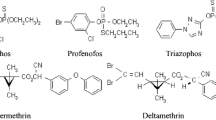Abstract
Dissipation and decontamination of the semisynthetic macrolide emamectin benzoate and the natural insecticide spinosad on cowpea pods were studied following field application at single and double doses of 11.0 and 22 and 73 and 146 g ai ha−1, respectively. Residues of these naturalytes were estimated using LC-MS/MS. The initial deposit of 0.073 and 0.153 mg kg−1 of emamectin benzoate dissipated below quantitation level on the fifth and seventh day at single and double dosage, respectively. For spinosad, the initial deposits of 0.94 and 1.90 mg kg−1 reached below quantitation level on the 7th day and 15th day at single and double dosage, respectively. The half-life of emamectin benzoate and spinosad was 1.13–1.49 and 1.05–1.39 days with the calculated safe waiting period of 2.99–6.12 and 1.09–3.25 days, respectively, for single and double dosage. Processing of the harvestable pods with different decontamination techniques resulted in 33.82 to 100 % removal 2 h after the application of emamectin benzoate and 100 % removal 3 days after spraying, while the removal was 42.05 to 87.46 % 2 h after the application of spinosad and 38.05 to 68.08 % 3 days after application.





Similar content being viewed by others
References
Aktar, M. W., Sengupta, D., Purkait, S., & Chowdhury, A. (2010). Risk assessment and decontamination of quinalphos under different culinary processes in/on cabbage. Environmental Monitoring Assessment, 163, 369–377.
Anastassiades, M., Lehotay, S. J., Stajnbaher, D., & Schenck, F. J. (2003). Fast and easy multiresidue method employing acetonitrile extraction/partitioning and “dispersive solid-phase extraction” for the determination of pesticide residues in produce. Journal of AOAC International, 86(2), 412–431.
Byrne, S. L., & Pinkerton, S. L. (2004). The effect of cooking on chlorpyrifos and 3,5,6-trichloro-2-pyridinol levels in chlorpyriphos fortified produce for use in refining dietary exposure. Journal of Agricultural Food Chemistry, 52, 7567–7573.
DG-SANCO (2009) European Commission Document No. SANCO/10684/2009
Europe Commission (2013) EU pesticides database. http://ec.europa.eu/sanco_pesticides/public/index.cfm. Accessed 29 Aug 2013
Feleke, Y. R. S., Pasquet, F., & Gepts, P. (2006). Development of PCR based chloroplast DNA markers that characterize domesticated cowpea (Vigna unguiculata spp unguiculata var. unguiculata) and highlight: its crop-weed complex. Plant Systematics and Evolution, 263, 75–87.
Gardenmo.net (2011) Retrieved from: http://www.gardenmo.net/vegetable-garden-2/decontamination-of-pesticide-residues-on-fruits-and-vegetables.html. (Accessed on: 28 Jan 2011)
Hoskin, W. M. (1961). Mathematical treatment of the rate of loss of pesticide residues. FAO Plant Protection Bulletin, 9, 163–168.
Kar, A., Mandal, K., & Singh, B. (2012). Decontamination of chlorantraniliprole residues on cabbage and cauliflower through household processing methods. Bulletin of Environmental Contamination and Toxicology. doi:10.1007/s00128-012-0534-x.
Li, M., Chen, W., Li, M., & Han, L. (2011). Dissipation and residues of emamectin benzoate study in paddy under field conditions. Bulletin of Environmental Contamination and Toxicology, 87, 699–702.
Mandal, K., Jyot, G., & Singh, B. (2009). Dissipation kinetics of spinosad on cauliflower (Brassica oleracea var. botrytis. L.) under subtropical conditions of Punjab, India. Bulletin of Environmental Contamination and Toxicology, 83, 808–811.
Sharma, H. C. (1998). Bionomics, host plant resistance, and management of the legume pod borer, Maruca vitrata—a review. Crop Protection, 17(5), 373–386.
Singh, S., & Battu, R. S. (2012). Dissipation kinetics of spinosad in cabbage (Brassica oleracea L. var. capitata). Toxicological & Environmental Chemistry, 94(2), 319–326.
Thompson, G. D., Dutton, R., & Spark, T. C. (2000). Spinosad—a case study: an example from a natural products discovery programme. Pest Management Science, 56, 696–702.
Acknowledgments
The authors wish to express their gratitude to the Kerala Agricultural University for providing field and analytical research facilities for the conduct of the study.
Author information
Authors and Affiliations
Corresponding author
Rights and permissions
About this article
Cite this article
Vijayasree, V., Bai, H., Mathew, T.B. et al. Dissipation kinetics and effect of different decontamination techniques on the residues of emamectin benzoate and spinosad in cowpea pods. Environ Monit Assess 186, 4499–4506 (2014). https://doi.org/10.1007/s10661-014-3714-9
Received:
Accepted:
Published:
Issue Date:
DOI: https://doi.org/10.1007/s10661-014-3714-9




